Characterizing a Heavy Dust Storm Event in 2021: Transport, Optical Properties and Impact, Using Multi-Sensor Data Observed in Jinan, China
Abstract
:1. Introduction
2. Instruments and Methods
2.1. Ground-Based Instruments
2.1.1. Micro Pulse Lidar—MPL
2.1.2. Environmental Dust Monitor-EDM 180
2.1.3. Monitor for Aerosols and Gases in Ambient Air—ADI 2080
2.2. Satellite Remote Sensing Instrument-MODIS
2.3. Backward Trajectory Modeling System-HYSPLIT
3. Results and Discussion
3.1. Weather Process
3.2. Optical Properties and Time–Height Evolution
3.3. Transport Paths
3.4. Dust Impacts
3.4.1. Characteristics of Particle Concentration and Size Distribution
3.4.2. Characteristics of Water-Soluble Particles in PM2.5
3.4.3. Vertical Structure Characteristics of Temperature
3.4.4. Characteristics of Surface Weather Constituent
4. Conclusions
- (1)
- Under the action of the strong Mongolian cyclone, a strong sandstorm occurred in Mongolia on 14 March. Driven by the cold and high pressure after the cyclone, the dust raised by the strong wind moved eastward and southward, affecting most parts of China. The dust arrived in Jinan at 20:00 on 14 March and settled on the ground at 16:00 on 15 March, affecting the local air quality.
- (2)
- The backward trajectory maps based on HYSPLIT model show that the transport paths of dust changed with time and were not completely identical at different heights. At the beginning, the dust affecting Jinan was from the west and south of Mongolia and the Gobi desert. Then, it came from eastern Mongolia and turned to be flow-back dust brought by the southeast air mass on the 17th.
- (3)
- The VDR value of dust observed by lidar was greater than 0.1, mainly around 0.2. The AE value of dust measured by MODIS was less than 0.25. The extinction coefficient observed by lidar and the AOD measured by MODIS are related to dust intensity. The stronger the dust is, the greater the values are. From the lidar observation, found that the higher the transport height was, the smaller the VDR of dust was. This indicates that the sand particles transported in the upper layer were smaller than those in the lower layer.
- (4)
- Dust pollution had an obvious impact on the characteristics of particles. In terms of mass concentration, PM1 remained stable, PM2.5 and PM10 increased rapidly, while the ratio of PM2.5 and PM10 decreased steeply. In terms of number concentration, particles between 0.25 and 0.58 micros reduced significantly, while particles larger than 0.58 micros expanded sharply. In terms of water-soluble ionic components, the secondary ion decreased while the calcium ion increased. The peak mass concentrations of PM2.5 and PM10 reached 573 µg/m3 and 3406 µg/m3, respectively. Additionally, the minimum ratio of the two reached 17%. The particle size of the dust was mainly distributed between 0.58–6.50 micros.
- (5)
- Dust also had an impact on the weather constituent and the vertical structure of air temperature. The pressure decreased in the early stage of dust, while the RH decreased after dust. In the process of dust weather, it becomes cold during the daytime and warm at night, and the diurnal variation of temperature is inconspicuous. A thin and thick inversion layer forms at night because the dust strongly absorbs the surface-outgoing infrared radiation at night.
- (6)
- Lidar, MODIS, EDM180 and ADI2080 can well identify dust. However, the result of MODIS is affected by observation time and cloud cover. EDM180 and ADI2080 can only capture the dust when it settles on the ground, so the beginning time of dust observed by them is later than that captured by lidar. Although lidar can monitor the vertical stratification and time evolution of dust, it cannot penetrate the polluted layer when the pollution is serious. So, through the combination of multi-platform instruments, the dust process, characteristics and its effects can be better described.
Author Contributions
Funding
Data Availability Statement
Acknowledgments
Conflicts of Interest
References
- Mohammadpour, K.; Sciortino, M.; Kaskaoutis, D.G.; Rashki, A. Classification of synoptic weather clusters associated with dust accumulation over southeastern areas of the Caspian Sea (Northeast Iran and Karakum desert). Aeolian Res. 2022, 54, 100771. [Google Scholar] [CrossRef]
- Choobari, O.A.; Zawar-Reza, P.; Sturman, A. The global distribution of mineral dust and its impacts on the climate system: A review. Atmos. Res. 2014, 138, 152–165. [Google Scholar] [CrossRef]
- Zender, C.S.; Miller, R.L.; Tegen, I. Quantifying mineral dust mass budgets: Terminology, constraints, and current estimates. Eos Trans. Am. Geophys. Union 2004, 85, 509–512. [Google Scholar] [CrossRef]
- Textor, C.; Schulz, M.; Guibert, S.; Kinne, S.; Balkanski, Y.; Bauer, S.; Berntsen, T.; Berglen, T.; Boucher, O.; Chin, M.; et al. Analysis and quantification of the diversities of aerosol life cycles within AeroCom. Atmos. Chem. Phys. 2006, 5, 8331–8420. [Google Scholar] [CrossRef] [Green Version]
- Zhao, S.P.; Yin, D.Y.; Qu, J.J. Identifying sources of dust based on CALIPSO, MODIS satellite data and backward trajectory model. Atmos. Pollut. Res. 2015, 6, 36–44. [Google Scholar] [CrossRef] [Green Version]
- Huo, W.; Song, M.; Wu, Y.; Zhi, X.; Yang, F.; Ma, M.; Zhou, C.; Yang, X.; Mamtimin, A.; He, Q. Relationships between near-surface horizontal dust fluxes and dust depositions at the centre and edge of the Taklamakan Desert. Land 2022, 11, 959. [Google Scholar] [CrossRef]
- Liu, J.; Zheng, Y.; Li, Z.; Flynn, C.; Welton, E.J.; Cribb, M. Transport, vertical structure and radiative properties of dust events in southeast China determined from ground and space sensors. Atmos. Environ. 2011, 45, 6469–6480. [Google Scholar] [CrossRef]
- Nabavi, S.O.; Haimberger, L.; Samimi, C. Climatology of dust distribution over West Asia from homogenized remote sensing data. Aeolian Res. 2016, 21, 93–107. [Google Scholar] [CrossRef] [Green Version]
- Jin, Q.; Wei, J.; Lau, W.K.; Pu, B.; Wang, C. Interactions of Asian mineral dust with Indian summer monsoon: Recent advances and challenges. Earth-Sci. Rev. 2021, 215, 103562. [Google Scholar] [CrossRef]
- Zhang, W.J.; Li, M.; Lv, B.; Lv, C.; Fu, H.; Jiang, T.; Chen, Y. Lidar detection analysis of a sand-dust process in Jinan. Environ. Monit. China 2019, 35, 165–176. [Google Scholar]
- Tang, K.; Huang, Z.; Huang, J.; Maki, T.; Zhang, S.; Shimizu, A.; Ma, X.; Shi, J.; Bi, J.; Zhou, T.; et al. Characterization of atmospheric bioaerosols along the transport pathway of Asian dust during the Dust-Bioaerosol 2016 Campaign. Atmos. Chem. Phys. 2018, 18, 7131–7148. [Google Scholar] [CrossRef] [Green Version]
- Honda, A.; Matsuda, Y.; Murayama, R.; Tsuji, K.; Nishikawa, M.; Koike, E.; Yoshida, S.; Ichinose, T.; Takano, H. Effects of Asian sand dust particles on the respiratory and immune system. J. Appl. Toxicol. 2014, 34, 250–257. [Google Scholar] [CrossRef] [PubMed] [Green Version]
- Arnold, C. Dust storms and human health: A call for more consistent, higher-quality studies. Environ. Health Perspect. 2020, 128, 114001. [Google Scholar] [CrossRef]
- Lee, H.; Kim, H.; Honda, Y.; Lim, Y.H.; Yi, S. Effect of Asian dust storms on daily mortality in seven metropolitan cities of Korea. Atmos. Environ. 2013, 79, 510–517. [Google Scholar] [CrossRef]
- Qian, L.; Yang, J.H.; Yang, X.L.; Yang, Y.L. Cause analysis of “2008.5.2” strong sandstorm in the eastern of Hexi corridor. Plateau Meteorol. 2010, 29, 719–725. [Google Scholar]
- He, Q.; Xiang, M.; Tang, S.J. Synoptic analyses of two strong sandstorms in the hinterland of Taklimakan desert. J. Desert Res. 1998, 18, 320–327. [Google Scholar]
- Shen, H.X.; Li, X.L.; Shi, B.J. Comparison analysis of two dust devil events in Beijing area. Meteorlogical Mon. 2004, 30, 12–16. [Google Scholar]
- Guo, X.N.; Wang, Y.; Ma, X.M.; Tan, C.R.; Zhang, X.Y.; Zhang, J.N.; Zhang, H.X.; Chen, J. Analysis of a typical heavy dust pollution weather in semi-arid region: A case study in eastern Qinghai. Acta Sci. Circumstantiae 2021, 41, 343–353. [Google Scholar]
- Peng, S.L.; Zhou, S.D.; Wei, K.J.; Shen, A. Causes and characteristics of a dust weather process in the Beijing-Tianjin-Hebei region. Trans. Atmos. Sci. 2019, 42, 926–935. [Google Scholar]
- Guo, X.N.; Ma, X.M.; Zhang, Q.M.; Tan, C.R.; Ma, Y.C.; Wang, N.; Wang, Y. Analysis of the transmission characteristics of a heavy dust pollution weather in Qinghai Plateau. Environ. Monit. China 2020, 36, 45–54. [Google Scholar]
- Yun, J.B.; Jiang, X.G.; Meng, X.F.; Xue-Hong, W.U.; Ying, C. Comparative analyses on some statistic characteristics between cold front and Mongolia cyclone dust storm processes. Plateau Meteorol. 2013, 32, 423–434. [Google Scholar]
- Wang, T.H.; Sun, M.X.; Huang, J.P. Research review on dust and pollution using space-borne lidar in China. Trans. Atmos. Sci. 2020, 43, 144–158. [Google Scholar]
- Liu, T.H.; Tsai, F.; Hsu, S.C.; Hsu, C.W.; Shiu, C.J.; Chen, W.N.; Tu, J.Y. South-eastward transport of Asian dust:source, transport and its contributions to Taiwan. Atmos. Environ. 2009, 43, 458–467. [Google Scholar] [CrossRef]
- Liu, D.; Wang, Z.; Liu, Z.; Winker, D.; Trepte, C. A height resolved global view of dust aerosols from the first year CALIPSO lidar measurements. J. Geophys. Res. Atmos. 2008, 113, D16214. [Google Scholar] [CrossRef]
- Qi, Y.L.; Ge, J.M.; Huang, J.P. Spatial and temporal distribution of MODIS and MISR aerosol optical depth over northern China and comparison with AERONET. Chin. Sci. Bull. 2013, 58, 2497–2506. [Google Scholar] [CrossRef] [Green Version]
- Eguchi, K.; Uno, I.; Yumimoto, K.; Takemura, T.; Shimizu, A.; Sugimoto, N.; Liu, Z. Trans-pacific dust transport: Integrated analysis of NASA/CALIPSO and a global aerosol transport model. Atmos. Chem. Phys. 2009, 9, 3137–3145. [Google Scholar] [CrossRef] [Green Version]
- Cao, X.J.; Zhang, L.; Zhou, B.; Bao, J.; Shi, J.S.; Bi, J.R. Lidar measurement of dust aerosol radiative property over Lanzhou. Plateau Meteorol. 2009, 28, 426–433. [Google Scholar]
- Bao, X.R.; Wang, L.N.; Yang, Y.P.; Tao, H.J.; Yang, L.L. Analysis of strong dust process in Lanzhou city: Based on Lidar. J. Arid. Land Resour. Environ. 2021, 35, 92–99. [Google Scholar]
- Huang, T.; Song, Y.; Hu, W.D. Lidar detection of a sand-dust process in Dalian, Liaoning, China. J. Desert Res. 2010, 30, 983–988. [Google Scholar]
- Deng, M.; Zhang, J.H.; Jiang, Y.L. Vertical distribution and source analysis of dust aerosol in Beijing under the influence of a dust storm. J. Meteorol. Sci. 2015, 35, 550–557. [Google Scholar]
- Liu, D.; Qi, F.D.; Jin, C.J.; Yue, G.; Zhou, J. Polarization lidar observations of cirrus clouds and Asian dust aerosols over Hefei. Chin. J. Atmos. Sci. 2003, 27, 1093–1100. [Google Scholar]
- Guo, B.J.; Liu, L.; Huang, D.P.; Wang, L.L.; Li, X.L. Analysis of lidar measurements from a dust event. Meteorol. Mon. 2008, 34, 52–57. [Google Scholar]
- Dong, X.H.; Nobuo, S.; Bai, X.C.; Qi, H.; Ren, L.J.; Wang, Y.P.; Di, Y.A.; Chen, Y.; Zhao, S.L.; Itiro, M. Application of lidar in sand storm observation—Analysis of dust events of Beijing and Hohhot in spring of 2004. J. Desert Res. 2006, 26, 942–947. [Google Scholar]
- Xia, J.R.; Wang, P.C.; Zong, X.M.; Chen, H.B.; Min, M. Stereo monitoring of a dust case using lidar and sun photometer. Environ. Monit. China 2011, 27, 74–81. [Google Scholar]
- Xu, D. Development of a Dust-Sand Storms Monitoring System Based on the Sun Photometer with a Preliminary Study on the Observation Precision Influence by Cloud. Master’s Thesis, Nanjing University of Information Science and Technology, Nanjing, China, 2008; pp. 9–18. [Google Scholar]
- Yuan, T.; Chen, S.; Huang, J.; Zhang, X.; Luo, Y.; Ma, X.; Zhang, G. Sensitivity of simulating a dust storm over Central Asia to different dust schemes using the WRF-Chem model. Atmos. Environ. 2019, 207, 16–29. [Google Scholar] [CrossRef]
- Ginoux, P.; Prospero, J.M.; Torres, O.; Chin, M. Long-term simulation of dust distribution with the GOCART model: Correlation with the North Atlantic Oscillation. Environ. Model. Softw. 2004, 19, 113–128. [Google Scholar] [CrossRef]
- Uno, I.; Wang, Z.; Chiba, M.; Chun, Y.S.; Gong, S.L.; Hara, Y.; Jung, E.; Lee, S.-S.; Liu, M.; Mikami, M.; et al. Dust model intercomparison (DMIP) study over Asia: Overview. J. Geophys. Res. 2006, 111, D12213. [Google Scholar] [CrossRef] [Green Version]
- Zender, C.S.; Bian, H.S.; Newman, D. The mineral dust entrainment and deposition (DEAD) model: Description and 1990s dust climatology. J. Geophys. Res. 2003, 108, 4416. [Google Scholar] [CrossRef] [Green Version]
- Luo, C.; Mahowald, N.M.; Corral, J. Sensitivity study of meteorological parameters on mineral aerosol mobilization, transport, and distribution. J. Geophys. Res. 2003, 108, 4447. [Google Scholar] [CrossRef] [Green Version]
- Han, Y.; Wu, Y.; Wang, T.; Xie, C.; Zhao, K.; Zhuang, B.; Li, S. Characterizing a persistent Asian dust transport event: Optical properties and impact on air quality through the ground-based and satellite measurements over Nanjing, China. Atmos. Environ. 2015, 115, 304–316. [Google Scholar] [CrossRef]
- Yoon, J.E.; Lim, J.H.; Shim, J.M.; Kwon, J.I.; Kim, I.N. Spring 2018 Asian dust events: Sources, transportation, and potential biogeochemical implications. Atmosphere 2019, 10, 276. [Google Scholar] [CrossRef] [Green Version]
- Huang, Y.; Chen, B.; Dong, L.; Zhang, Z. Analysis of a dust weather process over east Asia in May 2019 based on satellite and ground-based lidar. Chin. J. Atmos. Sci. 2021, 45, 524–538. (In Chinese) [Google Scholar]
- Shi, Z.L.; Zhang, X.B.; Zhang, R.C. Use of radionuclides to trace sand and dust sources of the March 15, 2021 dust storm event. J. Desert Res. 2022, 42, 1–5. [Google Scholar]
- Yang, X.J.; Zhang, Q.; Ye, P.L.; Qin, H.; Xu, L.; Ma, L.; Gong, C. Characteristics and causes of persistent sand-dust weather in mid-March 2021 over Northern China. J. Desert Res. 2021, 41, 245–255. [Google Scholar]
- Liang, P.; Chen, B.; Yang, X.P.; Liu, Q.; Zhang, D. Revealing the dust transport processes of the 2021 mega dust storm event in northern China. Sci. Bull. 2022, 67, 21–24. [Google Scholar] [CrossRef]
- Tian, X.M.; Liu, D.; Fu, S.L.; Wu, D.C.; Wang, B.X.; Wang, Z.; Wang, Y. Characterization of spring air pollution of Beijing in 2019 using active and passive remote sensing instrument. Int. Arch. Photogramm. Remote Sens. Spat. Inf. Sci. 2019, 42, 153–158. [Google Scholar] [CrossRef] [Green Version]
- Levy, R.; Hsu, C.; Sayer, A. MODIS Atmosphere L2 Aerosol Product. NASA MODIS Adaptive Processing System. Goddard Space Flight Cent. USA 2015. [Google Scholar] [CrossRef]
- Stein, A.F.; Draxler, R.R.; Rolph, G.D.; Stunder, B.J.B.; Cohen, M.D.; Ngan, F. NOAA’s HYSPLIT atmospheric transport and dispersion modeling system. Bull. Amer. Meteor. Soc. 2015, 96, 2059–2077. [Google Scholar] [CrossRef]
- Rolph, G.; Stein, A.; Stunder, B. Real-time Environmental Applications and Display System: Ready. Environ. Model. Softw. 2017, 95, 210–228. [Google Scholar] [CrossRef]
- Draxler, R.; Hess, G.D. An overview of HYSPLIT_4 modeling system for trajectories, dispersion and deposition. Aust. Meteorol. Mag. 1998, 47, 295–308. [Google Scholar]
- Al-Dousari, A.; Doronzo, D.; Ahmed, M. Types, indications and impact evaluation of sand and dust storms trajectories in the Arabian Gulf. Sustainability 2017, 9, 1526. [Google Scholar] [CrossRef] [Green Version]
- Cao, S.; Wu, D.; Chen, L.Z.; Xia, J.R.; Lu, J.G.; Liu, G.; Li, F.Y.; Yang, M. Pollution characteristics of water-soluble ions in atmospheric aerosols in China. Environ. Sci. Technol. 2016, 8, 103–115. [Google Scholar]
- Han, Y.M.; Shen, Z.X.; Cao, J.J.; Li, X.-X.; Zhao, J.-L.; Liu, P.P.; Wang, Y.H.; Zhou, J. Seasonal variations of water-soluble inorganic ions in atmospheric particles over Xi’an. Environ. Chem. 2009, 28, 261–266. [Google Scholar]
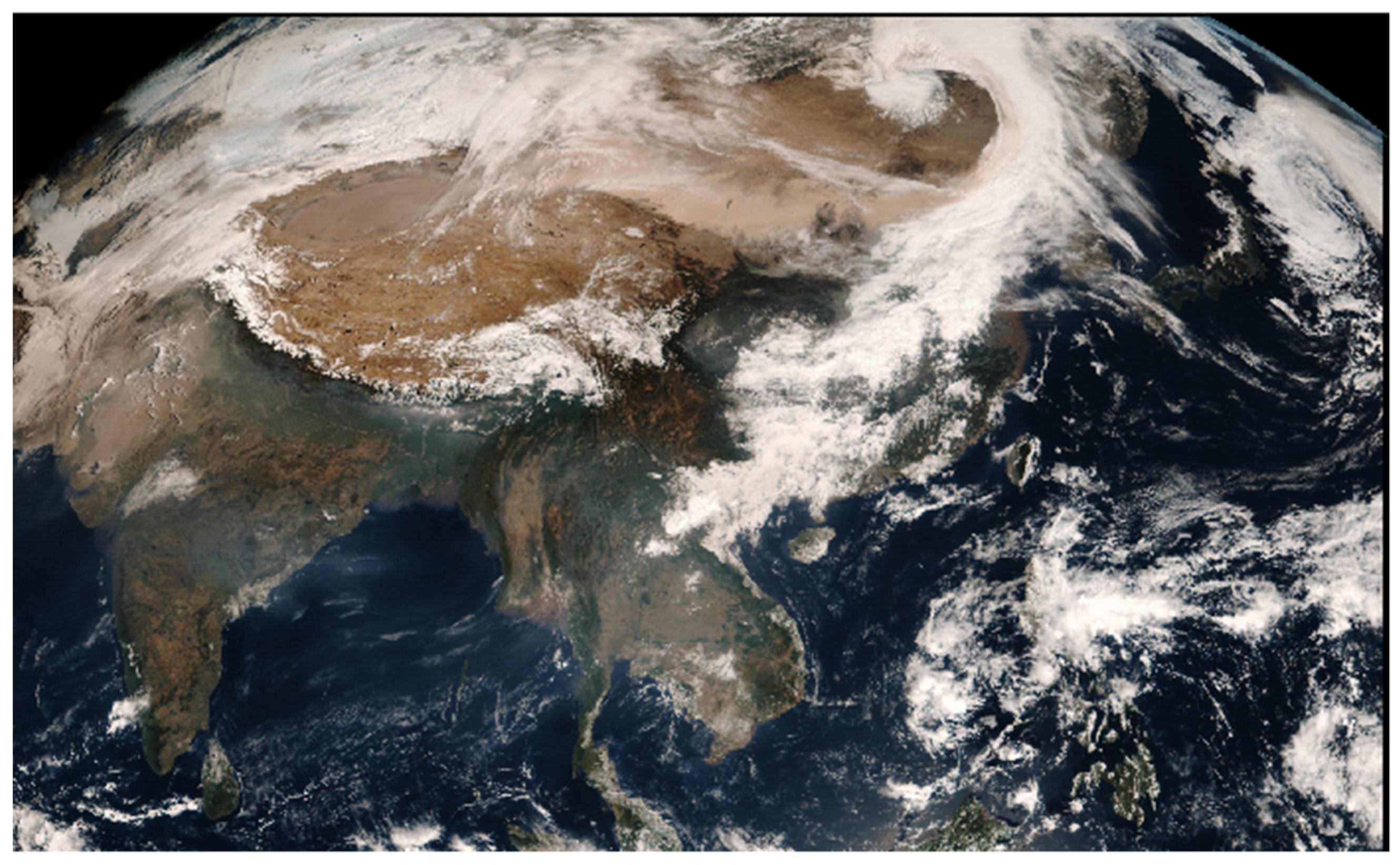

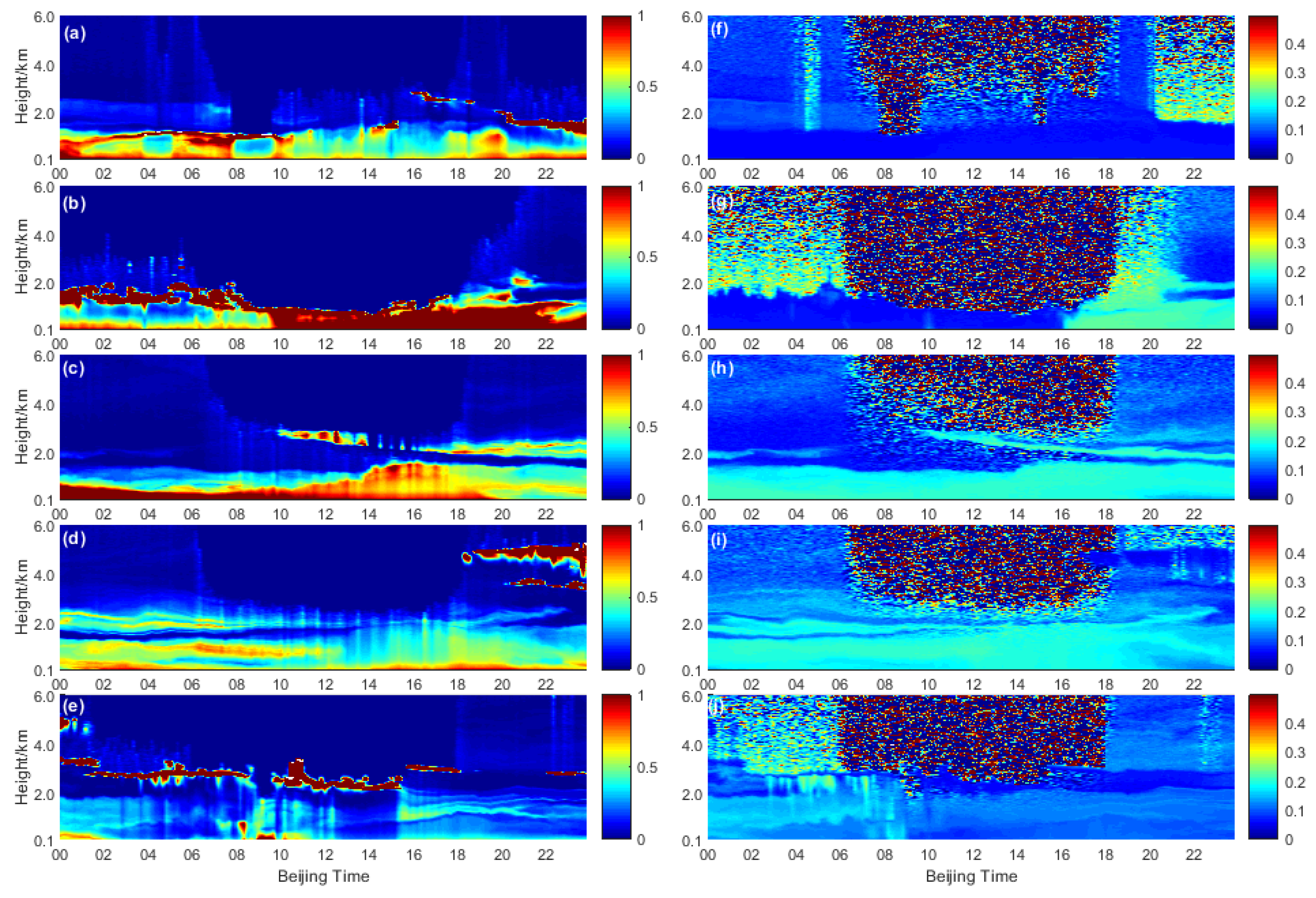
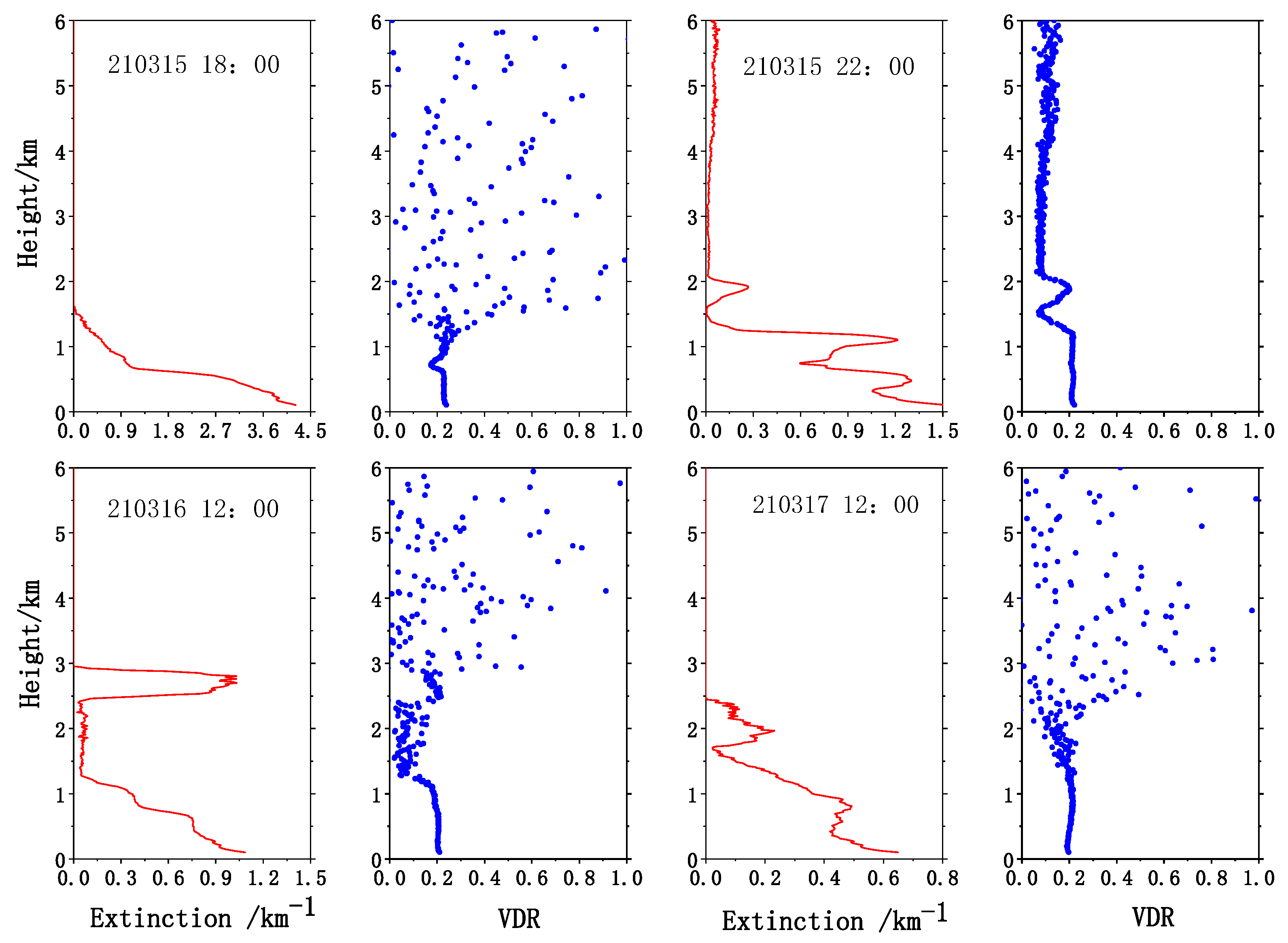
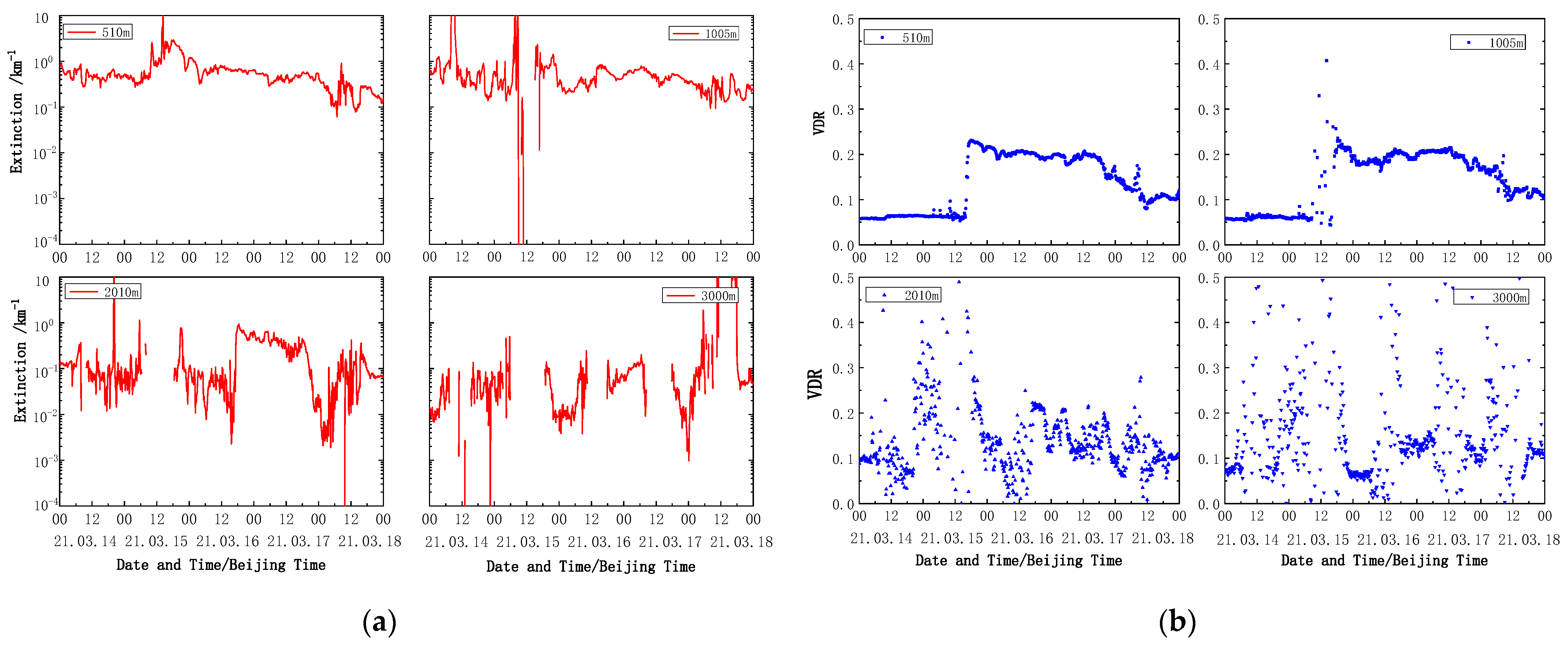
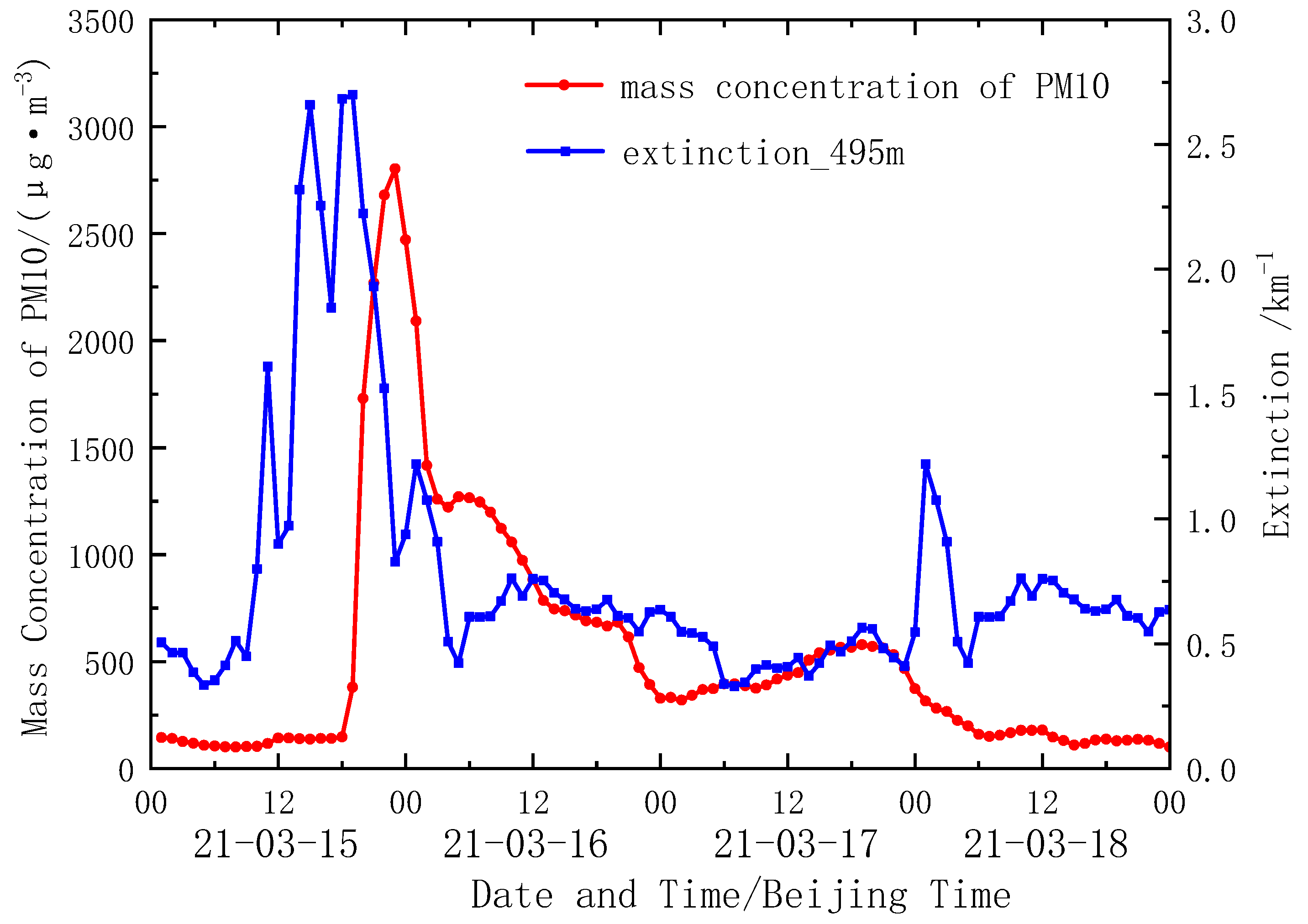
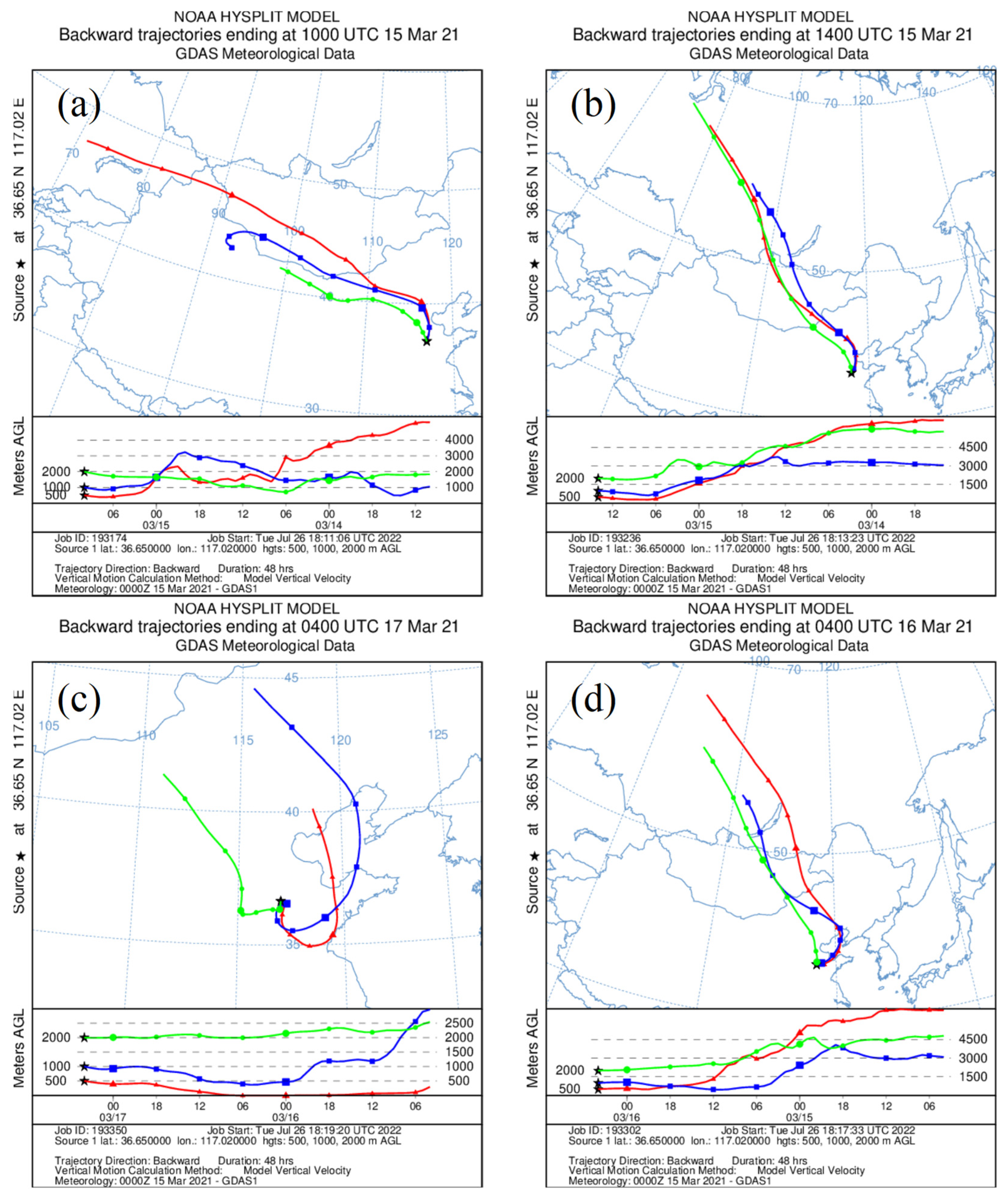
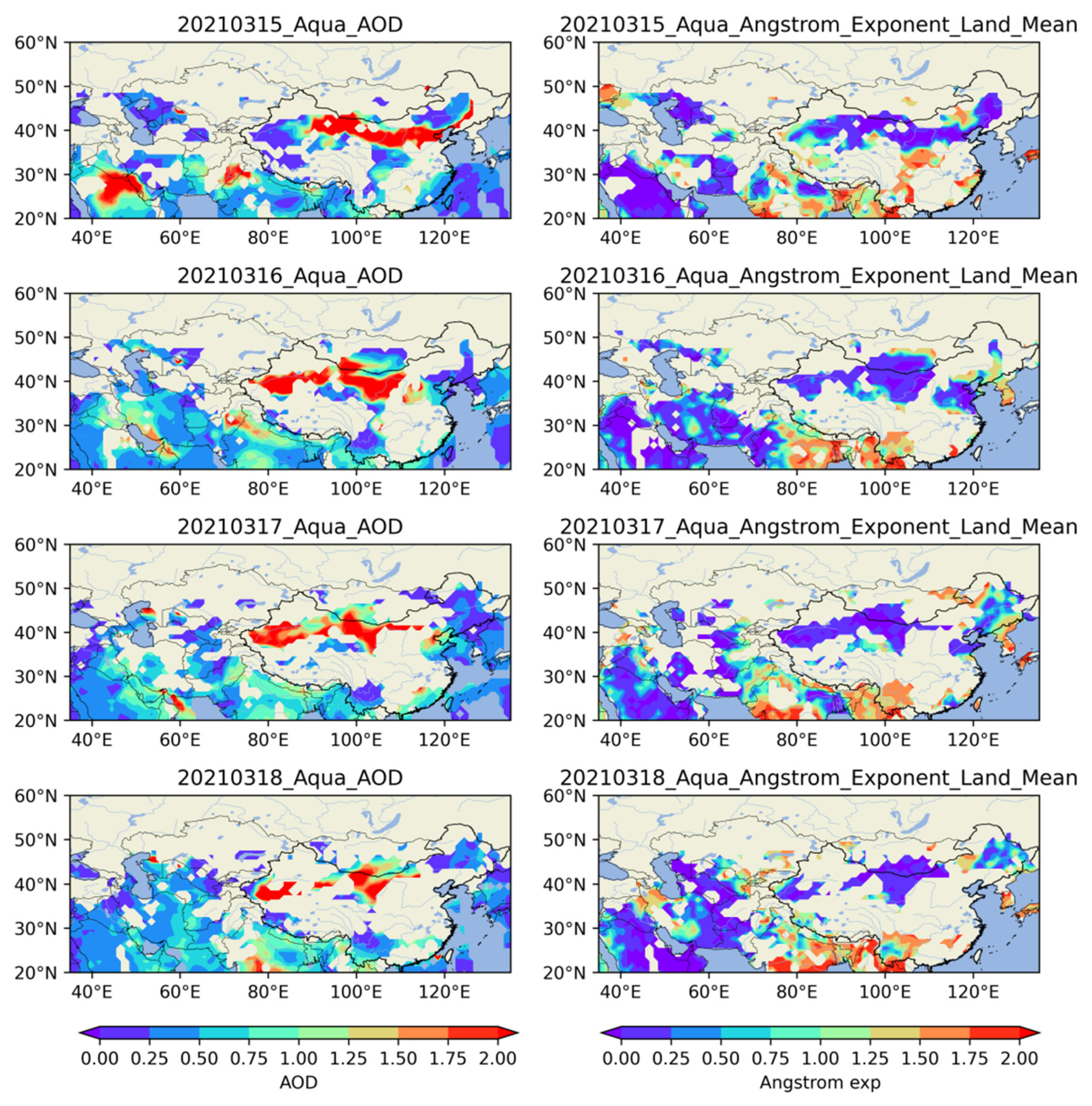
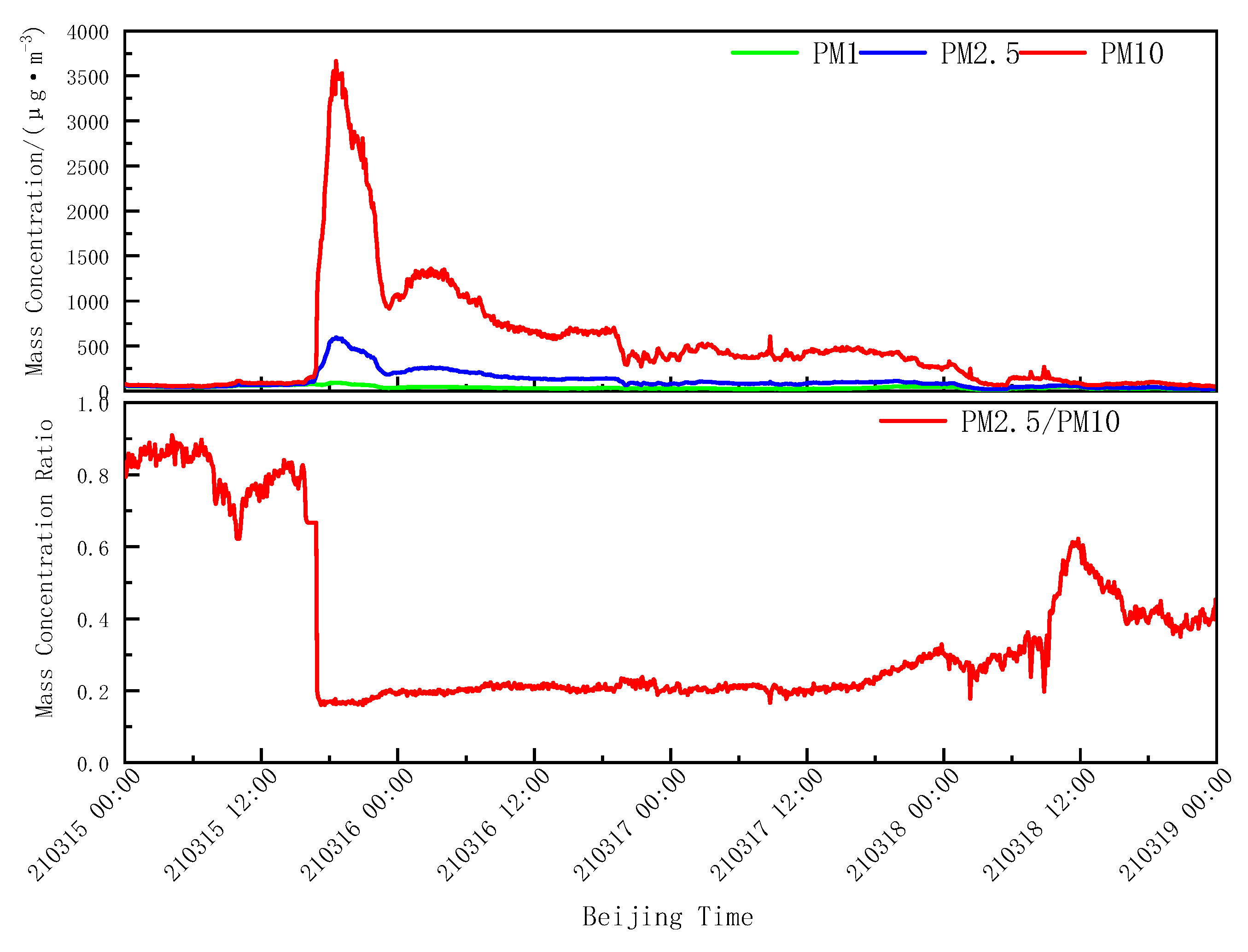

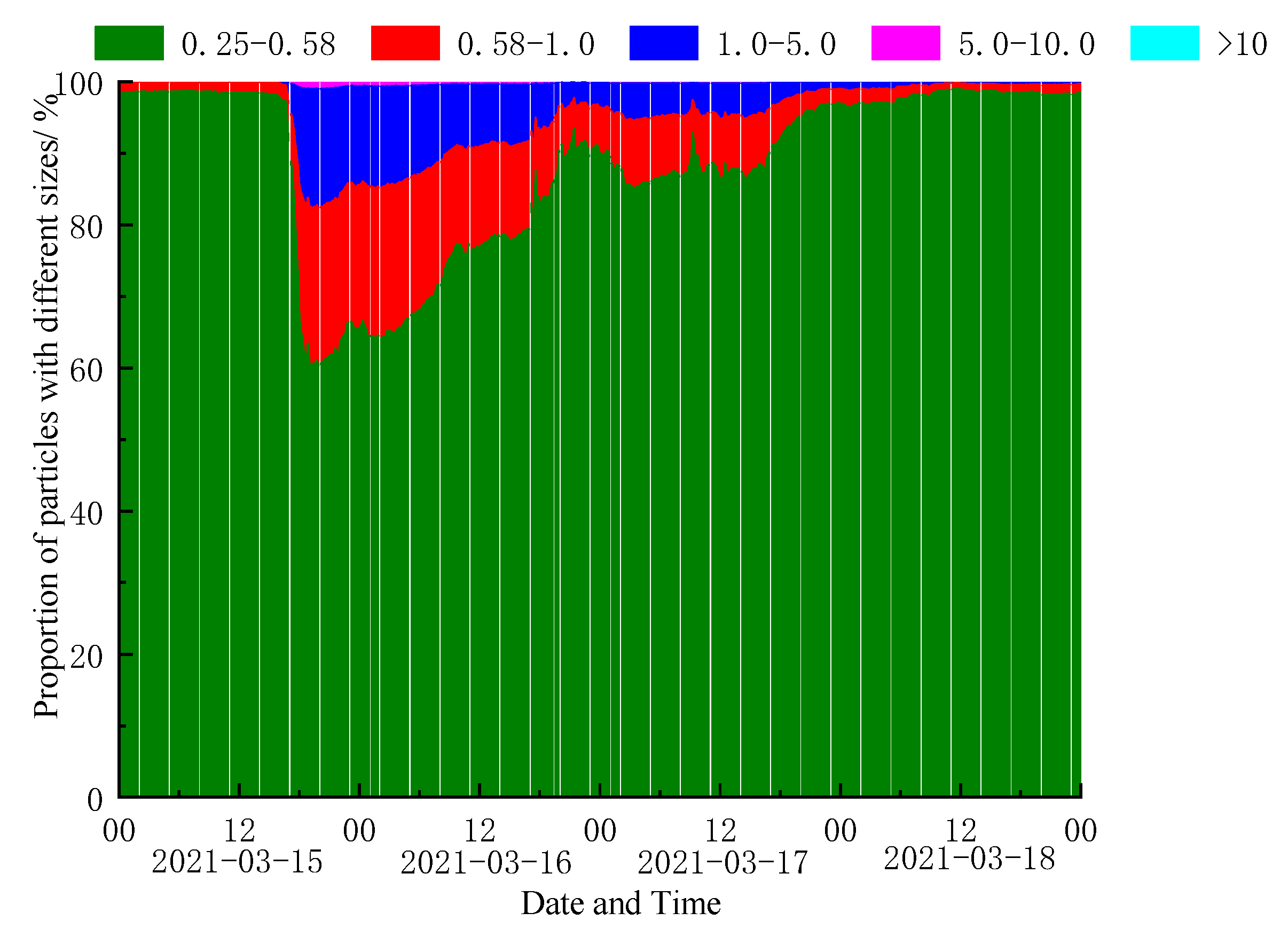


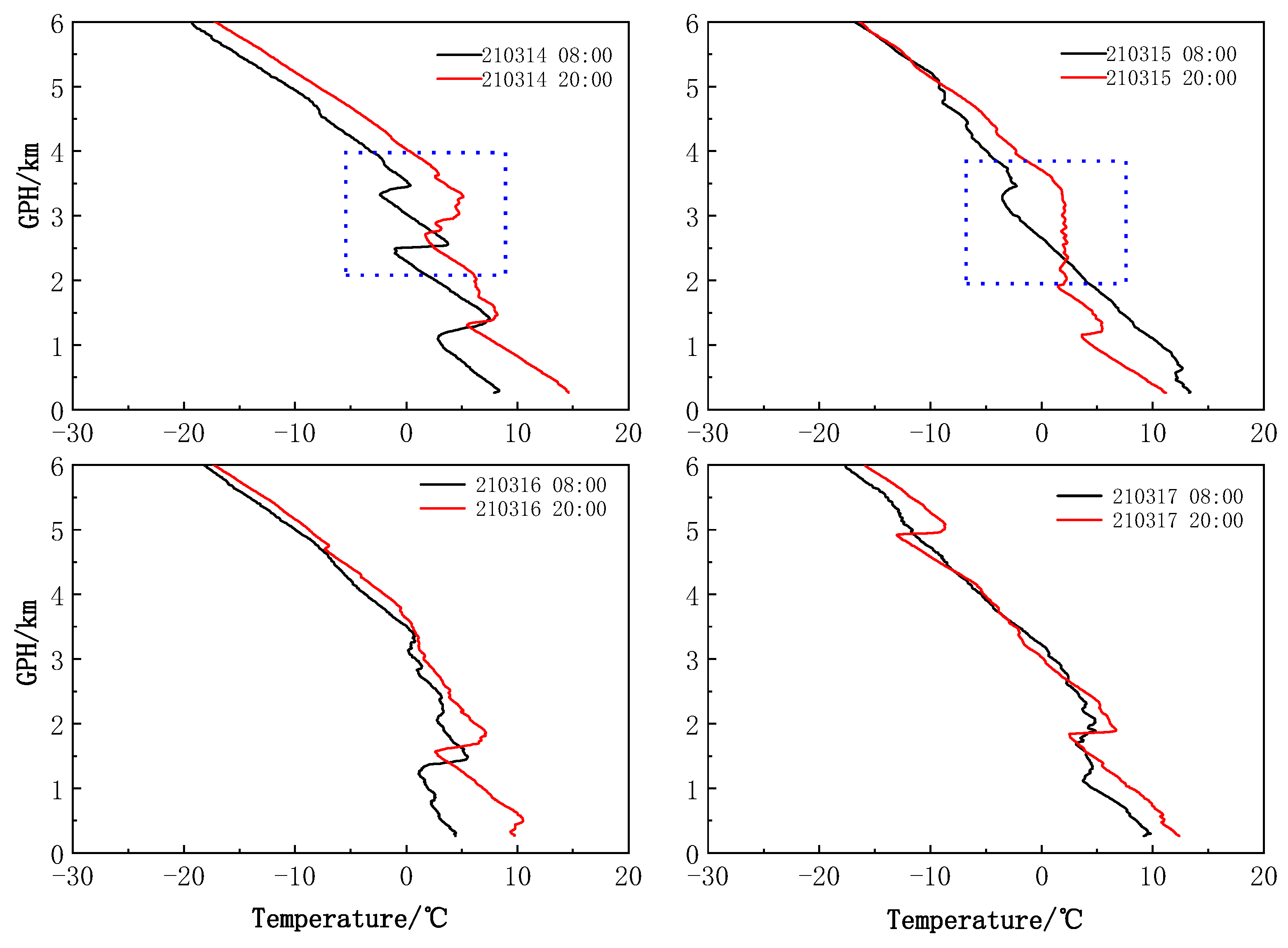

| N | D | N | D | N | D | N | D | N | D |
|---|---|---|---|---|---|---|---|---|---|
| 1 | >0.25 | 8 | >0.58 | 15 | >2.0 | 22 | >7.5 | 29 | >25.0 |
| 2 | >0.28 | 9 | >0.65 | 16 | >2.5 | 23 | >8.0 | 30 | >30.0 |
| 3 | >0.30 | 10 | >0.70 | 17 | >3.0 | 24 | >10.0 | 31 | >32.0 |
| 4 | >0.35 | 11 | >0.80 | 18 | >3.5 | 25 | >12.5 | ||
| 5 | >0.40 | 12 | >1.0 | 19 | >4.0 | 26 | >15.0 | ||
| 6 | >0.45 | 13 | >1.3 | 20 | >5.0 | 27 | >17.5 | ||
| 7 | >0.50 | 14 | >1.6 | 21 | >6.5 | 28 | >20.0 |
| Date | 0.25–0.58 µm | 0.58–1.0 µm | 1.0–5.0 µm | 5.0–10.0 µm | >10.0 µm | All |
|---|---|---|---|---|---|---|
| 03–14 | 9.42 × 108 | 8.99 × 106 | 6.88 × 105 | 2.87 × 104 | 2.56 × 103 | 9.52 × 108 |
| 03–15 | 8.14 × 108 | 3.70 × 107 | 2.02 × 107 | 1.12 × 106 | 3.57 × 104 | 8.73 × 108 |
| 03–16 | 2.28 × 108 | 4.03 × 107 | 2.56 × 107 | 1.12 × 106 | 3.08 × 104 | 2.95 × 108 |
| 03–17 | 3.60 × 108 | 2.23 × 107 | 1.23 × 107 | 6.13 × 105 | 1.93 × 104 | 3.95 × 108 |
| 03–18 | 4.55 × 108 | 6.06 × 106 | 2.33 × 106 | 1.36 × 105 | 6.77 × 103 | 4.63 × 108 |
Publisher’s Note: MDPI stays neutral with regard to jurisdictional claims in published maps and institutional affiliations. |
© 2022 by the authors. Licensee MDPI, Basel, Switzerland. This article is an open access article distributed under the terms and conditions of the Creative Commons Attribution (CC BY) license (https://creativecommons.org/licenses/by/4.0/).
Share and Cite
Tu, A.; Wang, Z.; Wang, Z.; Zhang, W.; Liu, C.; Zhu, X.; Li, J.; Zhang, Y.; Liu, D.; Weng, N. Characterizing a Heavy Dust Storm Event in 2021: Transport, Optical Properties and Impact, Using Multi-Sensor Data Observed in Jinan, China. Remote Sens. 2022, 14, 3593. https://doi.org/10.3390/rs14153593
Tu A, Wang Z, Wang Z, Zhang W, Liu C, Zhu X, Li J, Zhang Y, Liu D, Weng N. Characterizing a Heavy Dust Storm Event in 2021: Transport, Optical Properties and Impact, Using Multi-Sensor Data Observed in Jinan, China. Remote Sensing. 2022; 14(15):3593. https://doi.org/10.3390/rs14153593
Chicago/Turabian StyleTu, Aiqin, Zhenzhu Wang, Zhifei Wang, Wenjuan Zhang, Chang Liu, Xuanhao Zhu, Ji Li, Yujie Zhang, Dong Liu, and Ningquan Weng. 2022. "Characterizing a Heavy Dust Storm Event in 2021: Transport, Optical Properties and Impact, Using Multi-Sensor Data Observed in Jinan, China" Remote Sensing 14, no. 15: 3593. https://doi.org/10.3390/rs14153593
APA StyleTu, A., Wang, Z., Wang, Z., Zhang, W., Liu, C., Zhu, X., Li, J., Zhang, Y., Liu, D., & Weng, N. (2022). Characterizing a Heavy Dust Storm Event in 2021: Transport, Optical Properties and Impact, Using Multi-Sensor Data Observed in Jinan, China. Remote Sensing, 14(15), 3593. https://doi.org/10.3390/rs14153593







